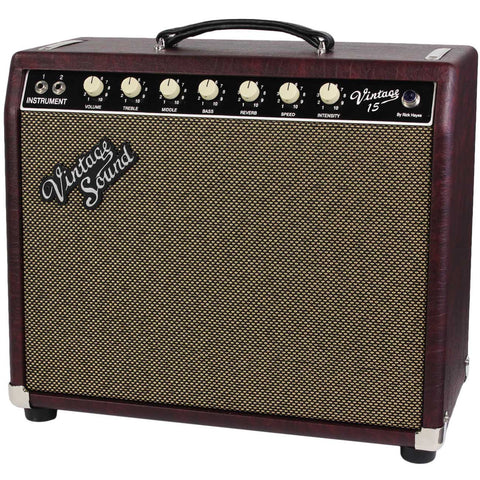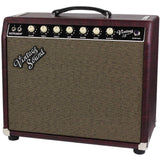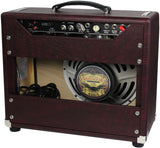Vintage Sound Vintage 15 Combo, Wine Taurus
- DESCRIPTION
The Vintage Sound Vintage 15 is essentially an all hand-wired, all USA made, super-modified Fender Princeton Reverb. It's based on the "blackface" Fender Princeton Reverb (AA1164) used from 1964-1967, but with several major and significant upgrades (read more below).
The Vintage 15 has a decent amount of warm, clean headroom for a 15 watt amp. As you turn the volume knob, it doesn't start breaking up until about 4 or 5 on the dial. It will easily hold it's own again any typical Deluxe Reverb out there. Players from all genres LOVE this amp - from Blues, to Country, to Rock!
Blah, blah, blah... We could go on and on with "salesman speak" as we like to call it, but let's get right down to the interesting stuff that really matters.
So exactly what are these upgrades, you ask?
1) The most obvious difference is the 12" speaker upgrade. The Princeton Reverb came with a 10" stock speaker, and many people modded them to replace the 10" baffle with a 12" so they could get a standard sized speaker in there. (more on the speaker we chose below)
2) The reverb circuit is vastly upgraded. The stock reverb on a Princeton was a small 9" pan spring reverb. The Vintage 15 uses a large 17" spring reverb pan that's the same size as the one used in the Twin Reverb! The reverb circuit also includes a very nifty reverb dwell control on the rear of the chassis for varying the decay time.
3) A "MIDDLE" tone control has been added that Princeton Reverb amps did not have. This addition does absolutely nothing to hurt the integrity of the circuit or tone. The original Fender circuit actually had a fixed mid tone was set permanently at 6.8k. Vintage Sound removed this resistor from the circuit and replaced it with a much more versatile 10k potentiometer. The result is you now have the ability to adjust this frequency range without compromising the original tone. If you want it to sound precisely like a blackface Princeton Reverb, just turn the port to around one o'clock on the dial and you're there. You want to scoop the mids a touch, pull back. Warn the tone a bit, turn up.
4) The Vintage 15 utilizes a 5AR4 rectifier instead of a 5Y3. This bumps the wattage a bit (from approx 12 watts to approx 15). Accordingly, Rick added grid and screen resistors (as seen in the Black Face AB763 circuitry). This gives the transformer more protection in case a tube fails catastrophically. Wait! You say you want the sound of a 5Y3 instead? No problem! Just swap it out. Easy as pie.
5) The addition of a Standby Switch. The original Princeton Reverb didn't have one. This one does.
6) External Bias Points have been added so as to more easily bias the amp when you swap out tubes. This was previously an upcharge, but starting in 2017 these are now included on the Vintage 15. Nice!
So, as you can see, the Vintage 15 has lots of upgrades to the original Princeton Reverb circuit without adversely affecting the vintage tone. As well, all Vintage Sound amps are point-to-point hand-wired using top quality filter caps and electrolytics, carbon comp resistors, Orange Drop tone caps, solid core push back wire, and custom transformers that are hand wound in the USA.
Vintage 15 Specifications:
Wattage: 15 watts (or 12 watts with 5Y3)
Preamp Tubes: 3 x 12AX7, 1 X 12AT7
Power Tubes: 2 x 6V6
Rectifier: 1 x 5AR4
Front Controls: Volume, Treble, Middle, Bass, Reverb, Speed, & Intensity.
Rear Controls: Dwell (for controlling the reverb decay time)
Effects: Large Pan, Tube Driven Spring Reverb, Tube Vibrato
Speaker: WGS G12C/S - 1 x 12" (read more about this speaker below)
Inputs: 2 Inputs
Auxiliary Input: RCA Footswitch Jack
Extension Speaker Jack: External Speaker Jack
Circuit: All Point-to-Point, Hand-wired
Cabinet: Dove-tail jointed solid pine w/Baltic Birch Plywood baffle and back panels
Light: Blue Jewel
Dimensions: 17" H x 19 7/8" W x 9 1/2" D (32 lbs)
The Vintage 15 has a decent amount of warm, clean headroom for a 15 watt amp. As you turn the volume knob, it doesn't start breaking up until about 4 or 5 on the dial. It will easily hold it's own again any typical Deluxe Reverb out there. Players from all genres LOVE this amp - from Blues, to Country, to Rock!
Blah, blah, blah... We could go on and on with "salesman speak" as we like to call it, but let's get right down to the interesting stuff that really matters.
So exactly what are these upgrades, you ask?
1) The most obvious difference is the 12" speaker upgrade. The Princeton Reverb came with a 10" stock speaker, and many people modded them to replace the 10" baffle with a 12" so they could get a standard sized speaker in there. (more on the speaker we chose below)
2) The reverb circuit is vastly upgraded. The stock reverb on a Princeton was a small 9" pan spring reverb. The Vintage 15 uses a large 17" spring reverb pan that's the same size as the one used in the Twin Reverb! The reverb circuit also includes a very nifty reverb dwell control on the rear of the chassis for varying the decay time.
3) A "MIDDLE" tone control has been added that Princeton Reverb amps did not have. This addition does absolutely nothing to hurt the integrity of the circuit or tone. The original Fender circuit actually had a fixed mid tone was set permanently at 6.8k. Vintage Sound removed this resistor from the circuit and replaced it with a much more versatile 10k potentiometer. The result is you now have the ability to adjust this frequency range without compromising the original tone. If you want it to sound precisely like a blackface Princeton Reverb, just turn the port to around one o'clock on the dial and you're there. You want to scoop the mids a touch, pull back. Warn the tone a bit, turn up.
4) The Vintage 15 utilizes a 5AR4 rectifier instead of a 5Y3. This bumps the wattage a bit (from approx 12 watts to approx 15). Accordingly, Rick added grid and screen resistors (as seen in the Black Face AB763 circuitry). This gives the transformer more protection in case a tube fails catastrophically. Wait! You say you want the sound of a 5Y3 instead? No problem! Just swap it out. Easy as pie.
5) The addition of a Standby Switch. The original Princeton Reverb didn't have one. This one does.
6) External Bias Points have been added so as to more easily bias the amp when you swap out tubes. This was previously an upcharge, but starting in 2017 these are now included on the Vintage 15. Nice!
So, as you can see, the Vintage 15 has lots of upgrades to the original Princeton Reverb circuit without adversely affecting the vintage tone. As well, all Vintage Sound amps are point-to-point hand-wired using top quality filter caps and electrolytics, carbon comp resistors, Orange Drop tone caps, solid core push back wire, and custom transformers that are hand wound in the USA.
Vintage 15 Specifications:
Wattage: 15 watts (or 12 watts with 5Y3)
Preamp Tubes: 3 x 12AX7, 1 X 12AT7
Power Tubes: 2 x 6V6
Rectifier: 1 x 5AR4
Front Controls: Volume, Treble, Middle, Bass, Reverb, Speed, & Intensity.
Rear Controls: Dwell (for controlling the reverb decay time)
Effects: Large Pan, Tube Driven Spring Reverb, Tube Vibrato
Speaker: WGS G12C/S - 1 x 12" (read more about this speaker below)
Inputs: 2 Inputs
Auxiliary Input: RCA Footswitch Jack
Extension Speaker Jack: External Speaker Jack
Circuit: All Point-to-Point, Hand-wired
Cabinet: Dove-tail jointed solid pine w/Baltic Birch Plywood baffle and back panels
Light: Blue Jewel
Dimensions: 17" H x 19 7/8" W x 9 1/2" D (32 lbs)











